Chile: Walking with Pumas 2022 September tour 2
7 November 2022

















































































After spending the afternoon sleeping in a cave, a female puma emerges and surveys the valley below, before figuring out her next move (image by Virginia Wilde)

Eyes locked with this incredible female puma, she sat calmly just metres away from us, relaxed in the pampas and mata vegetation (image by Virginia Wilde)

A puma heads down from her cave resting site in the Amarga Reserve, where she had spent many hours asleep and shaded (image by Virginia Wilde)

The pinkest of puma tongues! This female cub removes the water droplets from her nose with her tongue, having enjoyed a long morning drink from a puddle (image by Virginia Wilde)

The emerald green Austral Parakeet is the world’s most southerly parrot species. These mischievous birds normally live in flocks of 10-15 birds, although we saw a large flock of more than 40, feeding in the trees (image by Virginia Wilde)

Well that’s a sock to the eye! Puma cubs play-fight for hours, developing the tackles and moves that will later serve them well for hunting (image by Virginia Wilde)

A large female puma wipes the water droplets from her nose, shortly after having a drink (image by Virginia Wilde)

Teeth bared, this female puma making efforts to protect the kill she stole from another puma (image by Virginia Wilde)

A juvenile Andean Condor, with its distinctive brown plumage, that it will keep for around six years (image by Virginia Wilde)

Close-up of a puma resting on a rocky outcrop, enjoying the spring sunshine (image by Virginia Wilde)

A full view of Almirante Nieto, one of the mountains of the Paine Massif, Torres del Paine, reflected in Laguna Amarga (image by Virginia Wilde)
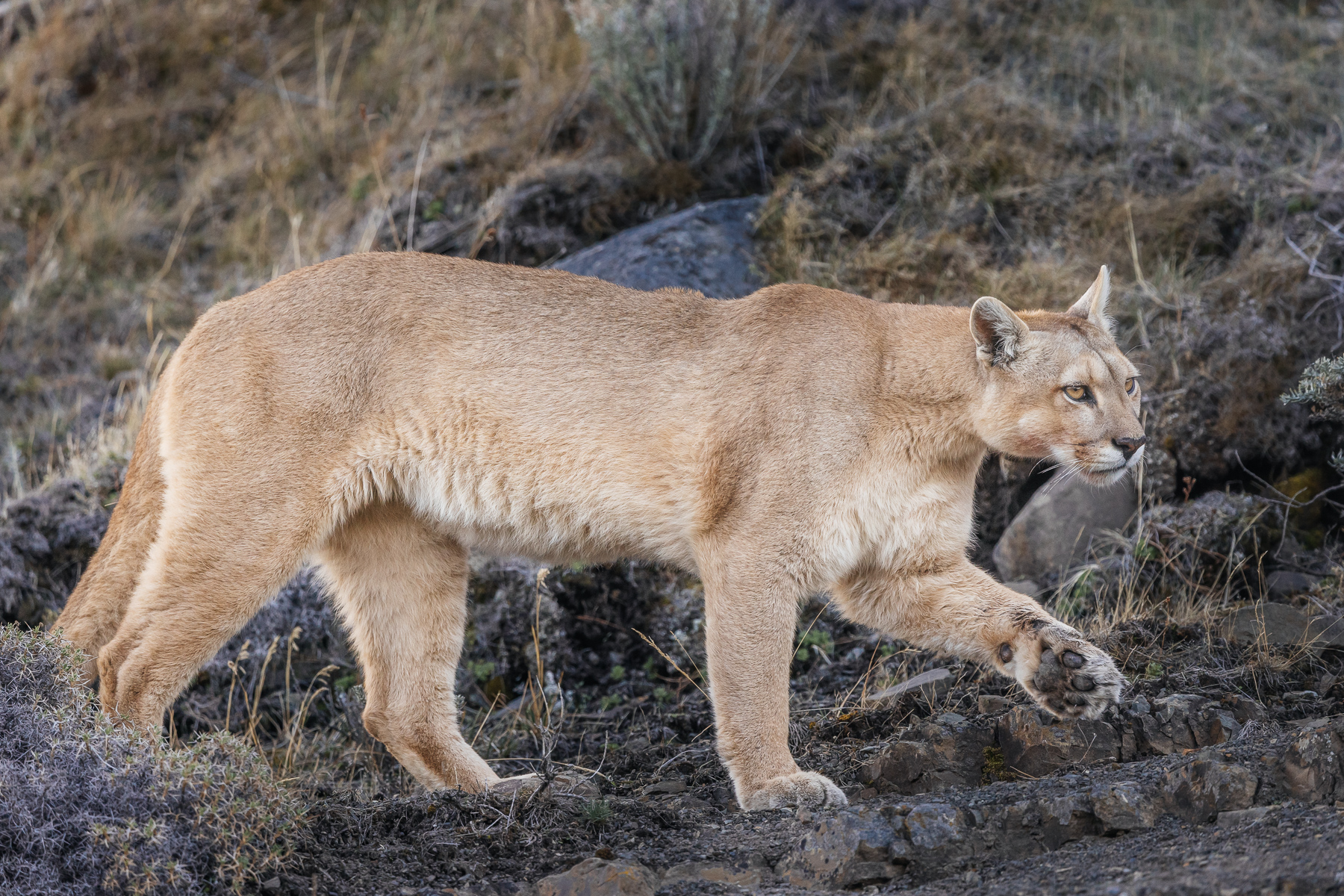
Female puma showing the size of one of her paws. Pumas have large paws relative to their bodies – needed for leaping and gripping their prey (image by Virginia Wilde)

A male Andean Condor, showing the yellow/brown eye, distinctive white collar and comb that distinguish them from the female (image by Virginia Wilde)

Morning mist swirls around Los Cuernos ‘The Horns’ of the Paine Massif, Torres del Paine National Park, Patagonia (image by Virginia Wilde)
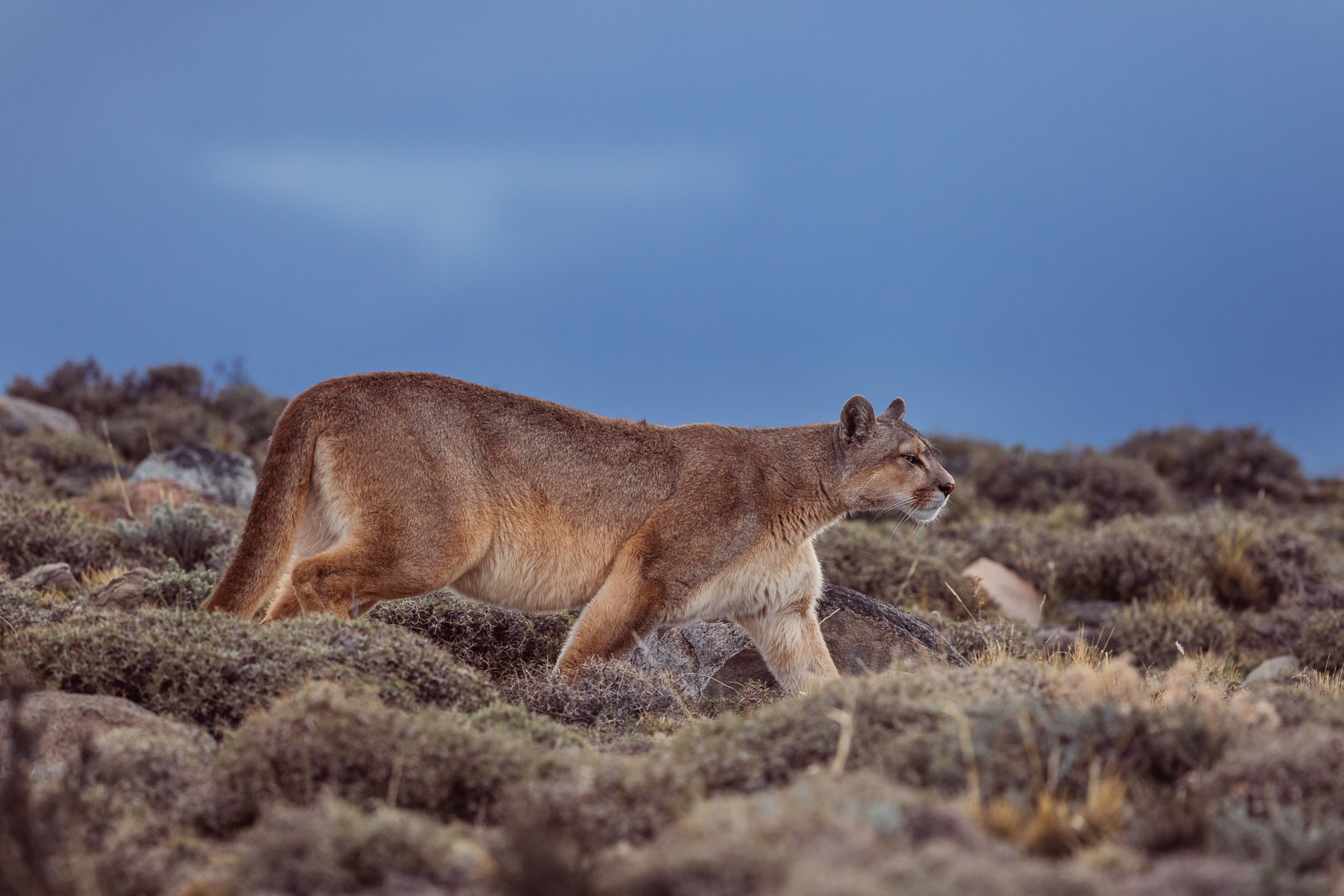
As the last remnants of evening light begin to fall, a female puma appears over the hill (image by Virginia Wilde)

Only one out of every five puma hunts is successful – which can be very tiring for the puma. With most hunts taking place at night, this female pads along in the pampas (image by Virginia Wilde)
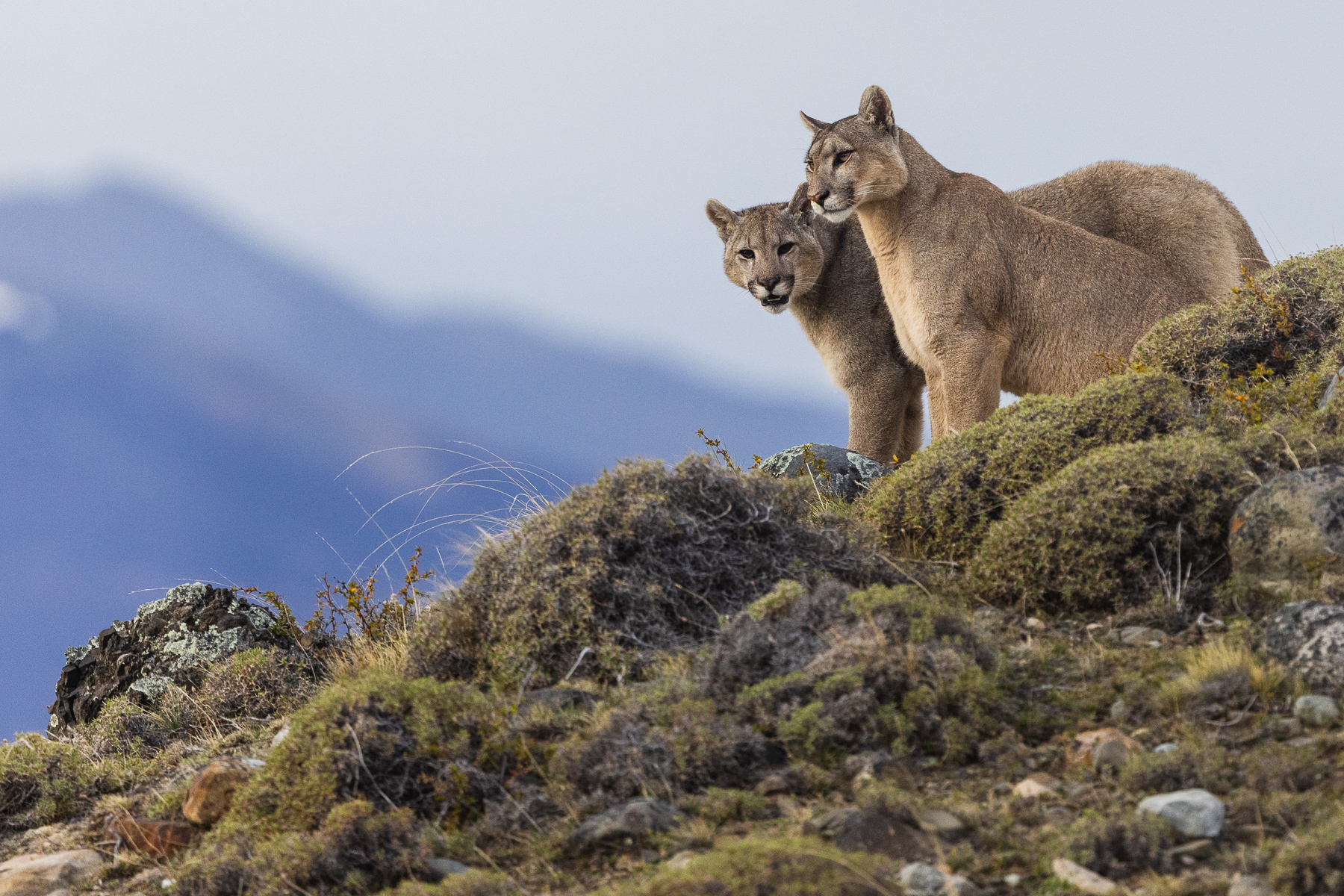
Watching from the hill down into the valley below – the female puma and her cub (image by Virginia Wilde)

Serrated edge detail of one of the ‘horns’ of Los Cuernos, one of the iconic mountains in the Paine Massif, Torres del Paine National Park (image by Virginia Wilde)

This puma walks in lockstep with her cub. Puma cubs spend up to two years with their mothers, who in turn, spend up to 80% of their adult lives having and caring for their young (image by Virginia Wilde)

A guanaco, lit up in the morning sunlight, traverses across a ridge in front of the mountains of the Paine Massif (image by Virginia Wilde)
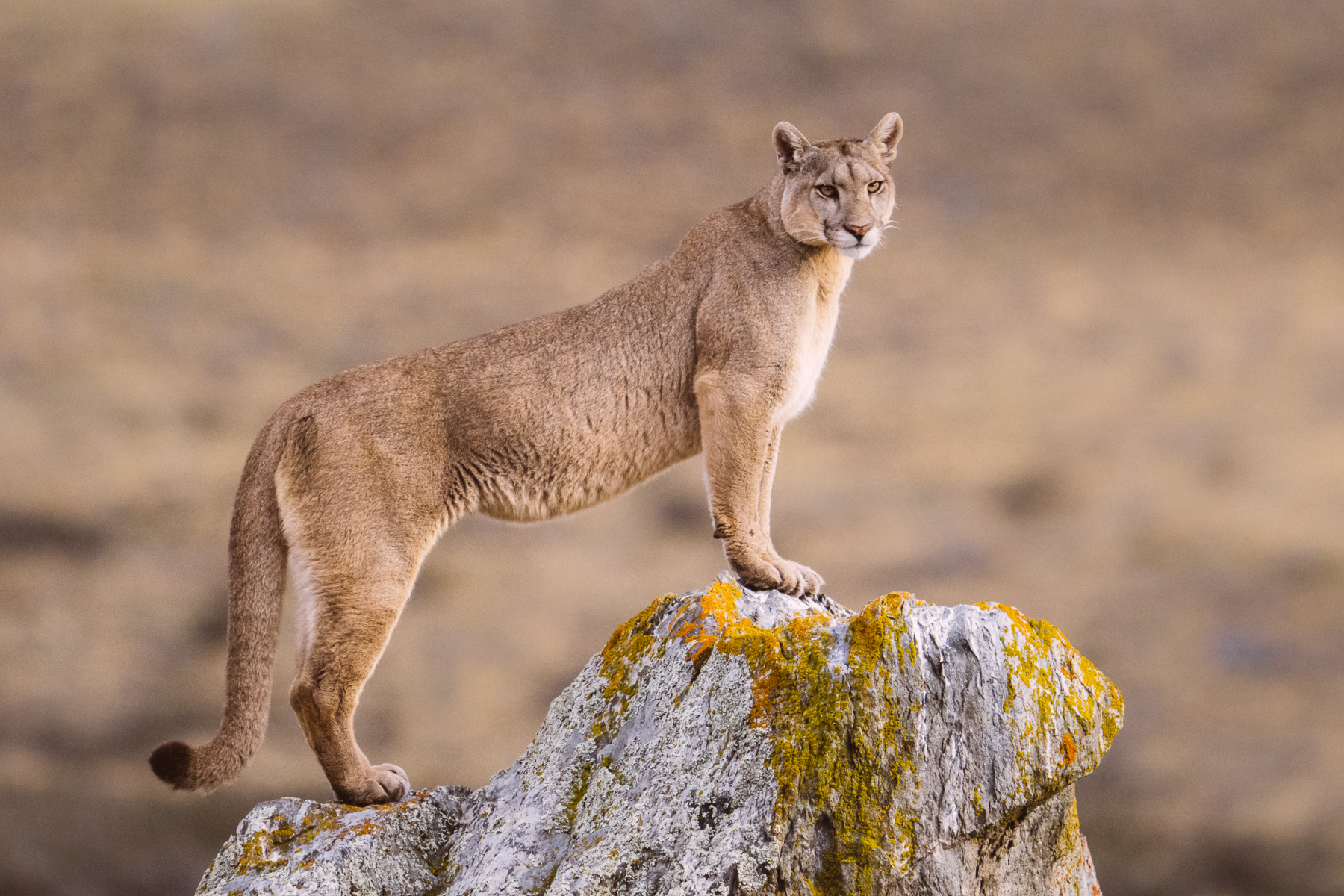
Looking majestic from atop of a large boulder, this female puma surveys the pampas below her and looks straight at us (image by Virginia Wilde)

In soft warm orange morning light, this female puma cub drinks from a puddle in the grass, just feet away from her mother and brother (image by Virginia Wilde)

As the last remnants of evening light begin to fall, a female puma appears over the hill, moving close by us as she continues down towards Lake Goic (image by Virginia Wilde)

It’s possibly disconcerting when a powerful predator looks directly at you, licking their lips (image by Virginia Wilde)

A female cub sits in the yellow grass, enjoying the warm sunshine from a bright Spring morning (image by Virginia Wilde)

Teeth bared, this female Puma making efforts to protect her kill, having stolen it from another female Puma (image by Virginia Wilde)

This puma female walks in lockstep with her cub (image by Virginia Wilde)

This puma looks as if she is almost amused, lying in lowland shrub in the reserve by the Torres del Paine National Park (image by Virginia Wilde)

A puma cub chews at the long grass. Entertained, like a domestic cat with string, by anything blowing in the wind (image by Virginia Wilde)

Right by the gates of the Torres del Paine National Park lay this female puma, her head peaking over rocks and just visible below (image by Virginia Wilde)

A female puma stares me directly in the eye, while sat in front of a neneo bush, whose beautiful red flowers were just beginning to poke through at the first hint of Spring (image by Virginia Wilde)

Pumas are so well camouflaged that they are sometimes difficult to spot (image by Virginia Wilde)

The sun starts to go down behind the towers (‘Torres’) of the Paine Massif, turning the lakeside water below orange (image by Virginia Wilde)

Three puma heads – eyes focused on a herd of guanacos across from the ridgeline. From left to right, the mother puma, her larger male cub and his smaller female sister (image by Virginia Wilde)

This female puma had a particularly wayward male cub who she lost twice during our tour so we found her, wandering through the pampas, calling for him (image by Virginia Wilde)

A one-year-old male puma cub, with light grey colouration, in the vegetation (image by Virginia Wilde)
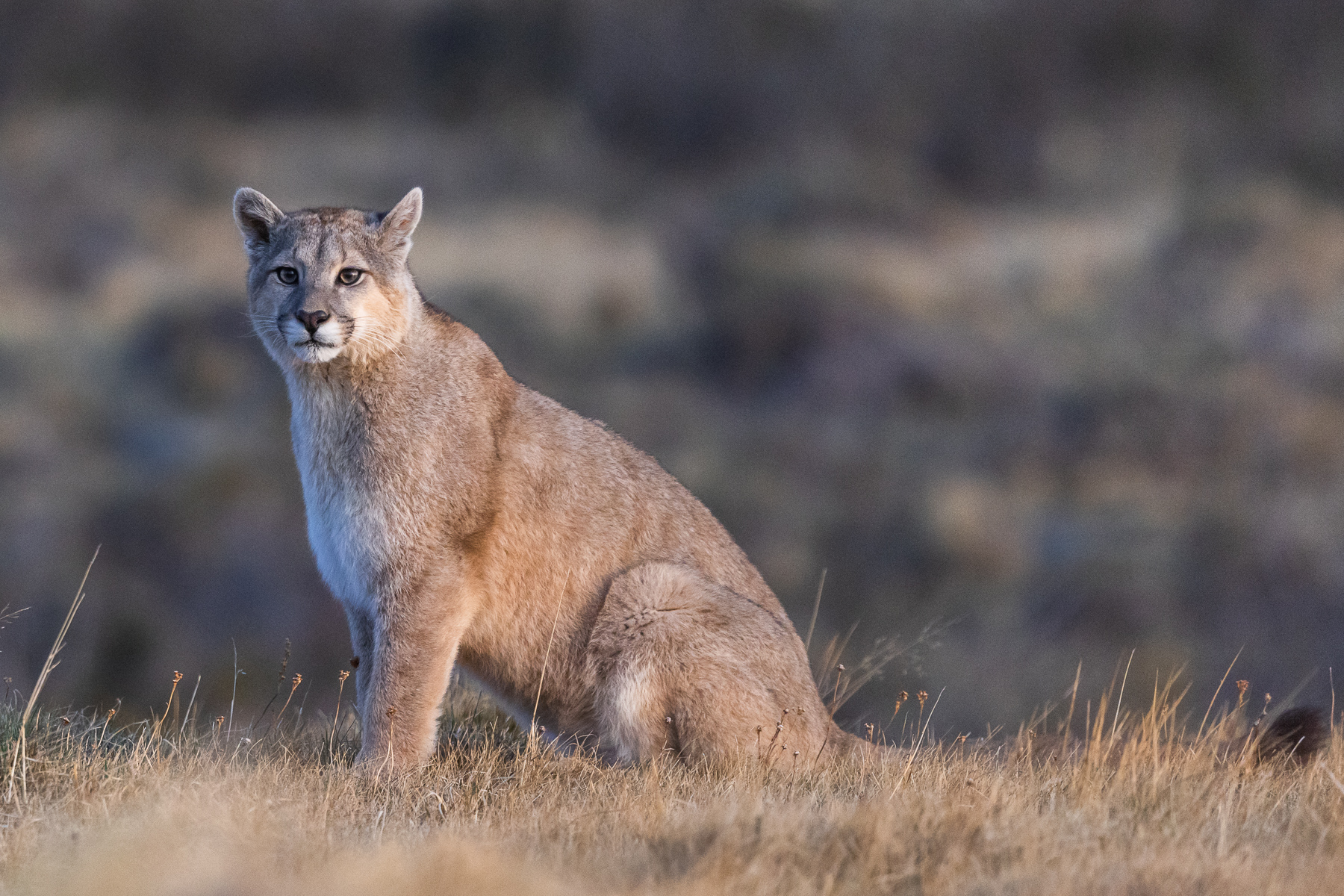
Portrait of a beautiful 12-month-old Puma cub (image by Virginia Wilde)

Growing up to a maximum of 21cm, the Austral Pygmy Owl is nevertheless a fearsome hunter – often taking down birds almost twice its own size (image by Virginia Wilde)

‘I’m here with you, mum!’ The affection of this year-old male cub towards his famous mother 'Blinka' is unmistakeable (image by Virginia Wilde)

Are you sure that tree branches are on the menu? A puma cub reaches and pulls down a tree branch, trying to break the shrub with his teeth (image by Virginia Wilde)

A female puma flops down in front of the mountains of the Paine Massif. Her eyes fixed on a herd of guanacos ahead of her in the distance (image by Virginia Wilde)

A watchful Guanaco, tail raised, picks its way through the pampas in early morning light (image by Virginia Wilde)

Having made a ‘nest’ upon prickly-looking vegetation, this tough-furred puma had a good vantage point to survey any goings-on from her rocky stronghold (image by Virginia Wilde)

Strolling along a low ridge, just feet away from us, this young female puma looked straight at me before continuing down into a valley (image by Virginia Wilde)

The powerful lower canines of a female puma (image by Virginia Wilde)

Another ‘Pride Rock’ shot, made famous by lovers of ‘The Lion King’. This female puma appears to bow (image by Virginia Wilde)

In soft morning light, this curious puma cub edges through the vegetation. Laguna Amarga Reserve, Patagonia (image by Virginia Wilde)

My turn to tackle you! Two puma cubs and their mum race through the grass, taking it in turns to tackle each other, chase and play. (image by Virginia Wilde)

After sitting atop a large boulder for ten minutes, surveying her realm, this female puma jumps down into the calafate (image by Virginia Wilde)

A female puma protectively stands over the guanaco carcass that she had stolen from another puma (image by Virginia Wilde)

A glimpse of the powerful legs and paws of a female Puma, as she pads through pampas grass (image by Virginia Wilde)

An ever-watchful Guanaco pictured at ‘blue hour’, moving along a ridgeline and keeping sentry on the valley below (image by Virginia Wilde)

Those beautiful paws! Pumas have big paws, relative to their size, aiding their ability to jump (image by Virginia Wilde)

A female puma paces downhill, through the prickly calafate shrubs, Patagonia (image by Virginia Wilde)

Stronger morning light hits a grass plateau, with the iconic Los Cuernos ‘horns’, of the Paine Massif, displayed behind (image by Virginia Wilde)

The deep concentration of a puma as she watches a herd of guanacos crossing over a ridge in the distance. Contemplating a possible hunt maybe? (image by Virginia Wilde)

Having found the perfect puma-sized plateau, this puma flops down for a well-earned sleep (image by Virginia Wilde)

A year-old-female puma cub in pampas grass, in the reserve that borders the Torres del Paine National Park (image by Virginia Wilde)

Here’s looking at you! Female pumas can be very pretty cats (image by Virginia Wilde)

The morning mist swirls around some of the peaks in the Paine Massif, Torres del Paine National Park (image by Virginia Wilde)

The distinctive ruby red eyes of the Fire-eyed Diucon – a grey flycatcher endemic to southern South America (image by Virginia Wilde)

Small puffs of cloud appear as orange mist above the peaks next to the three iconic ‘Towers’ of the Paine Massif, Torres del Paine National Park (image by Virginia Wilde)

The beautiful brown mottled plumage of a juvenile Andean Condor, starting to develop its adult colouration, with its primaries (wingtips) the first to turn black (image by Virginia Wilde)

Out in ‘blue hour’ that time photographers love, this female puma appeared over the ridge (image by Virginia Wilde)

Using a small rock to give her some elevation, this female puma scans the horizon for signs of guanaco herd prey (image by Virginia Wilde)

Teeth bared, this female puma making efforts to protect her kill (image by Virginia Wilde)

Front legs tucked inward for speed, this puma cub bounds through grassland, looking to pounce on his sister in play (image by Virginia Wilde)

It’s the ‘Pride Rock’ shot, made famous by lovers of ‘The Lion King’. This female puma surveys her Kingdom from atop of a lichen covered rock, as her two ten-month-old cubs play below (image by Virginia Wilde)
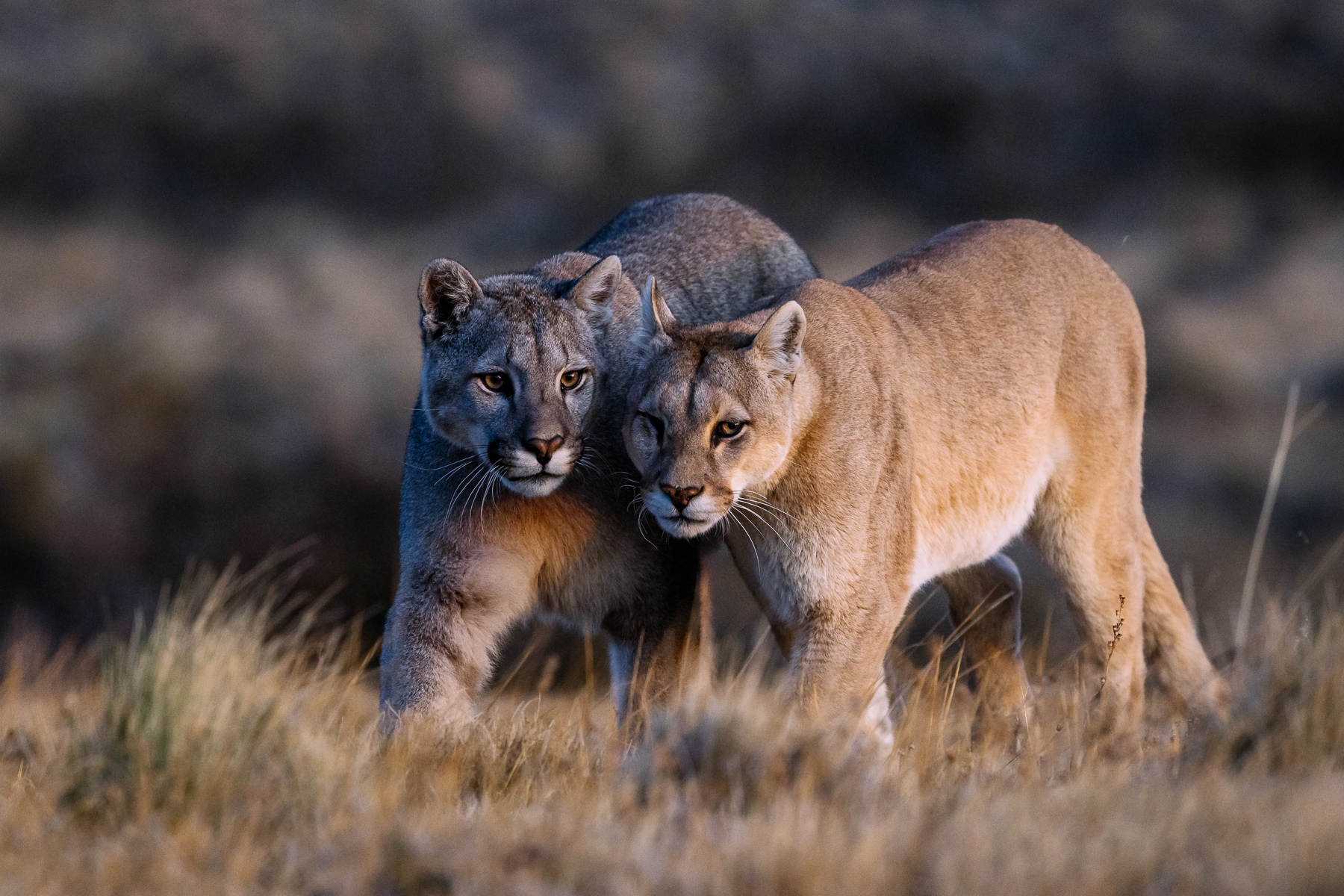
Blinka walking with her protective male cub (image by Virginia Wilde)

Serrated edge detail of one of the ‘horns’ of Los Cuernos, one of the iconic mountains in the Paine Massif, Torres del Paine National Park (image by Virginia Wilde)

After spending four hours sleeping tucked into the crevice of a cave, this female puma starts to emerge (image by Virginia Wilde)

A puma cub stands watchful in the vegetation, Laguna Amarga reserve, Patagonia (image by Virginia Wilde)

Eye-level with an Andean Condor. A juvenile condor – its plumage still characteristically brown – looks right at us (image by Virginia Wilde)

This young female puma had just woken up, having spent hours sleeping in a bush (image by Virginia Wilde)
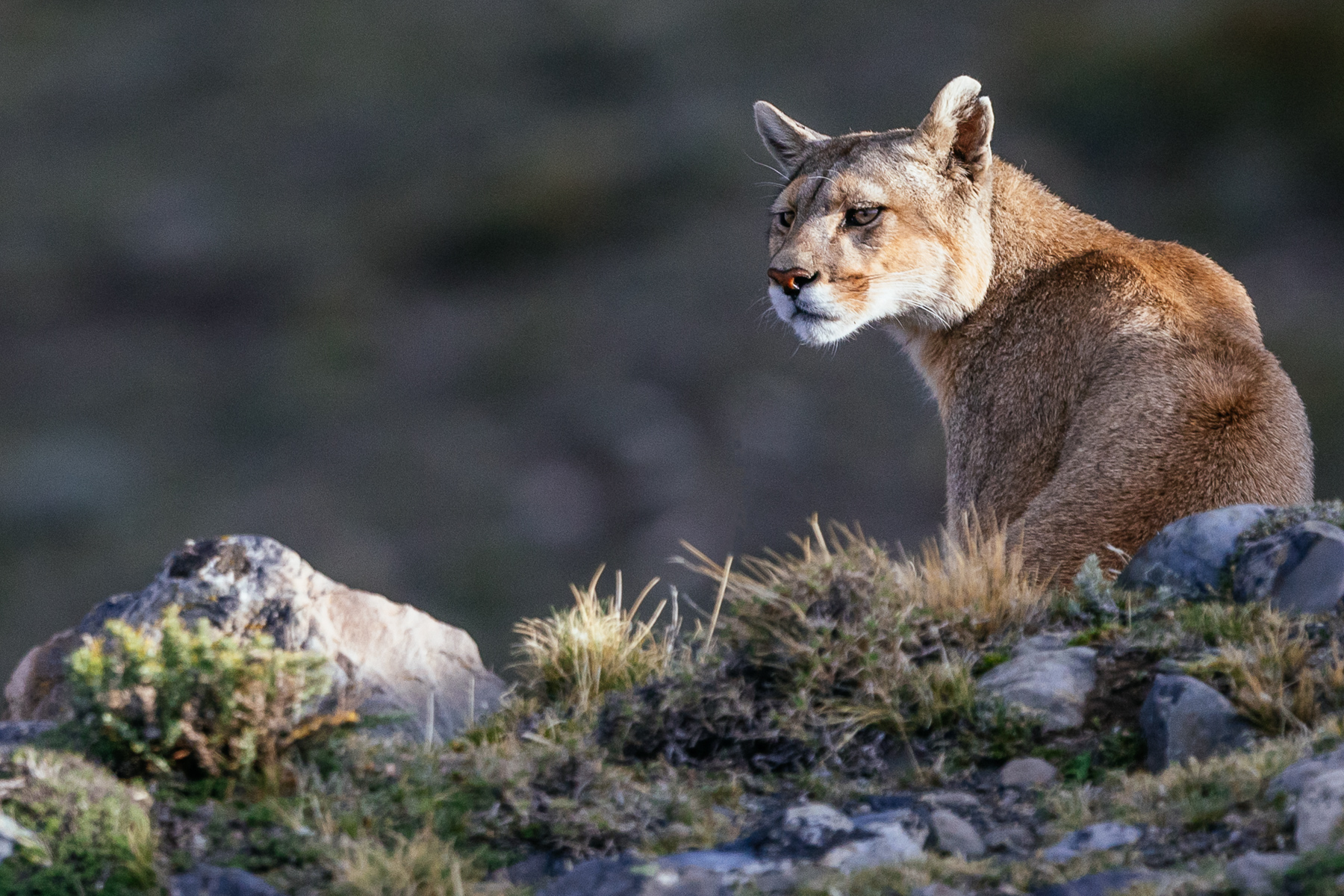
Eyes staring intently at a herd of guanacos in front of a ridge in the distance, this female puma weighs up so many options before deciding to start a hunt. (image by Virginia Wilde)

Witnessing Andean Condors soar in front of the iconic mountain range of the Torres del Paine National Park, is always a spectacular sight (image by Virginia Wilde)

A puma cub bounds through the grassland, moments before pouncing on his sister and tackling her to the ground (image by Virginia Wilde)

Basking in the Spring sunshine (loving the warmth like all cats) (image by Virginia Wilde)

Looking straight at us, the female puma rests, with the iconic ‘towers’ of the Paine Massif, Torres del Paine National Park, visible behind her (image by Virginia Wilde)
There are some wildlife experiences so exquisite that to witness them is to feel a rush of privilege and wonder – those hold-your-breath moments that become markers in a storied life.
In amongst them – if you’re lucky – maybe even a handful of times when you transcend from mere onlooker; where there is almost a crossover, an acceptance from a powerful wild animal that you can not only stay, but perhaps journey alongside them for a while. Not just observing them in their dominion, but briefly part of it too.
And there, in a nutshell, is what has customarily made the Wild Images ‘Walking with Pumas’ tour so very special. In our second September 2022 tour, just like the one immediately preceding it, we not only came within a few feet of the great mountain lion of the Americas, but moved in lockstep with, and in company of, these incredible animals.
On one occasion, we kept abreast with a normally solitary female as she wandered down from her cave in a narrow escarpment, pausing alongside us to sit in front of mountains streaked with blue shadows, before heading onwards towards a previous day’s kill.
And the time we walked beside a female puma and her cubs through a valley clearing, whereupon she leapt atop a large boulder and posed as an empress surveying her realm.
On a further morning – already noted for its stunning palette of orange and pink sunlight – we stood as another set of cubs bounded through the calafate shrub towards us; a male cub moving to then walk cheek-by-cheek with his mother. A moment of genuine beauty and so close that we felt we could almost reach out and touch it.
As if such experiences with these normally elusive big cats were not enough, the stronghold for these mountain lions is backdropped by the peaks of Patagonia’s iconic Torres del Paine National Park. With its dramatic spires in shades of dark and grey (sedimentary rock overlaid with granite) Patagonia sees your mountains and raises them, inimitable bookends in an already epic sweep of landscape.
If a wild animal could possibly choose a more magnificent or – for photography purposes, more picturesque – hunting ground, many of us are yet to see it. So not only were we able to search for, and walk with, pumas in an area known for having probably the highest concentration of these incredible big cats anywhere in the world, we did so in a region of unrivalled scenery. Not a bad foundation for any wildlife tour!
WELCOME TO PATAGONIA
Our tour began in Punta Arenas, a city whose bawling weather and drawn-out, sweeping shoreline accompany its edge-of-a-continent feel.
Situated on the Brunswick Peninsula of the Magellan Strait, the city not only serves as a gateway for modern Antarctic exploration but also reverberates with the echoes of past adventurers, most notably Sir Earnest Shackleton and Ferdinand Magellan, after whom the region is named.
In its museums and street art, Punta Arenas also rightly pays homage to its canoe-faring indigenous people, such as the Kawésqar, who navigated this strait (a vital passage between the Atlantic and Pacific Oceans) long before any western expeditions.
At our hotel, near the city’s pier with its flocks of Imperial Cormorants and Dolphin Gulls, we shared our first dinner with our wonderful Chilean co-guide Jorge Valenzuela, a gifted naturalist.
ANDEAN CONDORS – SOUTH AMERICA’S GREAT MESSENGER OF THE SKIES
If pumas are the Chilean Andes’ land predator in chief, then the Andean Condor is its lord of the skies. These vast birds, believed by the Inca Empire to carry the dead to the afterlife on their wings, never failed to impress us whenever they soared overhead.
Before journeying north towards Torres del Paine and our puma tracking ground, we spent a day at Estancia Olga Teresa, host to what is believed to be the world’s most accessible condor roost.
As many as 200 Andean Condors roost communally along the estancia’s towering cliff ridge, becoming more active towards the afternoon and riding the thermals for hours at a time with barely a wing-flap.
Considered the largest flying bird in the world by combined measurement of wingspan and weight (full adult wingspans can approach 11ft) to see these vultures effortlessly soar both beneath and above us, was to witness a species perfectly attuned for Patagonia’s windswept conditions.
And as far as photographic experiences go, it is a rewarding one. Wait just a few minutes and a condor will come. And by the afternoon, both the valley beneath the ridge and the sky above, were full of these splendid birds.
Both the male and females share black-and-white upper wing patterns, with males sporting a comb, large neck wattle and yellow/brown rather than red eyes. Juveniles are distinctive too, with greyish-brown feathers and a brown ruff.
In between our time at the condor ridge, we had coffee in a small outdoor clearing, surrounded by trees covered in mistletoe and lichen. Jose, from the estancia, gave us a tour of the ranch stables, woolshed and of his particularly large ‘pet’ sheep, whose brothers had allegedly all been taken by a puma.
Driving north along the road that heads up to the Pacific end of the Strait of Magellan, we also saw many of the birds that would become familiar throughout our tour. In the inlet, Magellanic Oystercatchers, Upland and Ashy-headed Geese by the shore. In the water, Flightless Steamer Ducks and regal Black-necked Swans.
And in the meadows, the endemic Lesser Rhea, Black-chested Buzzard Eagles and Crested Caracaras on a carcass, then the beautiful Long-tailed Meadowlark, Austral Negrita, Rufous collared sparrow, red-backed Austral Negrito and Scale-throated Earthcreeper.
On a fence, as we returned for more condors, a Chilean Flicker emerged in front of us – just one of many sightings in a day of avian spectacle.
HEADING NORTH TO THE MOUNTAINS AND OUR PUMA TRACKING BASE
Given that the weather forecast for our tour had been rather foreboding, predicting rain and limpid light, we were instead gifted dry, clear days that showcased the stunning mountains of the Paine Massif.
One of the two possible exceptions being, firstly, the blustery day of our drive from Punta Arenas, north to Puerto Natales and then to the estancia that would become our home for seven nights. And on another morning, while trying to photograph pumas feeding from a kill, the wind was so strong that some of us had to kneel to steady our cameras.
Puerto Natales, home to one of the best pizza restaurants in Chilean Patagonia (at which we duly lunched) has the feel of an outdoor-lovers town. Out by the jetty lap the waters of the Last Hope Sound. In the distance stand some of the last representatives of the Andes Mountains, before the range finally ends its 5,000-mile continent-conquering reign, continuing only hidden, beneath the sea.
Here we also got our first look at the Southern Patagonian Ice Field, straddling the border of Patagonia and Chile. Totalling more than 6,000 square miles in area, it’s one of the largest non-polar glaciers on Earth.
Heading onwards from Puerto Natales, the road arcs inland, becoming all grand curves amid more mountainous terrain. Our base for the following week – Estancia El Ovejero, in the small farming settlement of Cerro Castillo. The warmth of this estancia and its staff (not to forget their excellent wines) became a source of daily happiness throughout our tour.
PUMAS – IN SEARCH OF PATAGONIA’S INCREDIBLE MOUNTAIN LIONS
And so began our days tracking the Patagonian Puma – technically Puma concolor puma, according to the most recent taxonomic revision of Cats (Felidae).
Guided by our tracker, the talented biologist and puma specialist Jorge, our mornings typically started at 6.15am, with a drive out into the reserve that is home to one of the highest concentrations of pumas in the world.
One of the best features of Wild Images Tours is our work with fantastically talented local guides. The gifted biologist, Jorge, radioing through suspected puma movements to our group (image by Virginia Wilde)
Our tracking ground – the 6,200 hectare Laguna Amarga reserve, a private land which enabled us the freedom to walk off-trail, a privilege not permitted in the bordering Torres del Paine National Park.
With its healthy prey base of guanacos, and an estimated 20-30 most frequently seen cats, there is no better place in the world where wildlife-lovers can walk so closely alongside a wild puma, if accompanied by an experienced tracker and if the cat itself permits it.
Of course, the puma itself recognises no such boundaries. On several days we saw both pumas and guanacos jumping the border fence from the national park, often favouring the distinct sandstone rock conglomerates and cave systems of the reserve and the hunting grounds of Lake Goic and ‘Central Valley’ to the park behind.
The puma’s Latin name means ‘cat of one colour’, which stands at odds to the fact that coat colours can vary a great deal, from brown to rufous to the pale grey of cubs, together with a sandy hue that enables these cats to camouflage well amidst the Patagonian shrub.
Even the puma’s name can be an evasive one. Named and renamed constantly in different countries and by native peoples, this species has accumulated almost 80 different appellations – more than any other animal.
From ‘mountain lion’ to ‘cougar’, ‘catamount’ to ‘red tiger’, this elusiveness has only added to the air of mystery around the cat.
Tracking a puma on foot can be an exhilarating but exhausting endeavour. There are so many caves, rocks and areas of vegetation, such as the prickly shrubs ‘Mata Negra’, ‘Mata Verosa’ and ‘Calafate’ in which these animals can hide. We became so used to picking small thorns out of our trousers that we joked that all the plants in the reserve were conspiring to attack us!
And then there’s the fact that pumas can move great distances to go hunting at night, and also blend in so well with their surroundings. Often, it was the flash of a puma’s white underbelly or chin that finally gave them away. Although the most sure-fire way of finding a puma is after they are ‘outed’ by their prey – the well-organised guanacos with sentinel watchmen who ‘neigh’ if they see or smell their feared hunters.
Most days we would begin by heading west along the shores of the 14-mile-long Lake Sarmiento, itself dominated by the majestic Cordillera del Paine mountains, with its centrepiece the iconic Torres (towers).
From there, with Jorge Cardenas tracking ahead of us, we would either scan along the fossil-like formations of thrombolites and stromatolites beside both Lake Sarmiento and Lake Goic, head up into the ‘Central Valley’ region strewn with guanaco bones, or further into the hunting grounds flanked by a series of rock conglomerates.
A REAL INSIGHT INTO PUMA BEHAVIOUR
One of the best features of the Wild Images ‘Walking with Pumas’ tour is the relatively high number of days devoted to tracking and photographing these mountain lions. And on this particular tour, we bore witness to some incredible behaviour.
There was the haunting sound of a female puma, ‘Coiron’, calling after picking up the scent of the reserve’s dominant male, ‘Dark’. Part guttural growl, part elongated scream, we stood silently as the large male puma suddenly appeared through the shadows behind her. In fading light – and after we had spent time earlier that day photographing ‘Coiron’ as she groomed and slept by us on a rocky ledge – it was spellbinding to observe some of the rituals that precede any mating behaviour.
And then there are the behaviours that illustrate just how difficult it is to survive as a puma in this wilderness. Guanaco hunts fail nine times out of ten because the camelids are both so big and so effective at warning calls. Not to mention the fact that one kick in the head from a guanaco can be fatal.
The puma behavioural trait of sharing a kill – whether it stems from a necessary reciprocity in order to survive, or represents some other social function – was one we observed on several occasions.
There was the day we snoozed in warm sunshine in pampas grass just metres away from a sleeping ‘Petaka’ and her cubs, who had, just the previous evening, taken ownership of fellow female puma ‘Sol’s’ guanaco kill. Between ‘Sol’ intermittently searching and calling for her lost male cub (whom she later found) Petaka kept a continuous half-awake eye on the carcass, ‘permitting’ Sol just one meal at her own kill; growling and hissing when she deemed the thwarted puma had taken enough.
We also got an insight into the efforts that go into both making a successful kill and hiding it from the scores of either scavengers – condors, black-chested buzzard eagles and caracaras – or predators – foxes and, not to mention other pumas – that also seek to feed on guanaco remains.
We watched on as the female puma ‘Ginger’ left a nearly finished kill to go hunting again, her eyes zeroing on a guanaco that had just jumped the boundary fence from the Torres del Paine National Park into the reserve. She dropped low and started her crawling advance, trying to avoid detection by the sentinel guanaco stationed above the line of vegetation. Until her efforts were finally foiled by a third guanaco who signalled the alarm.
So many of these encounters provided fantastic photographic opportunities and we were incredibly fortunate in having a guide who was both highly ethical and with a deep love and understanding for these intelligent animals. And tracking on foot gave an intimacy of experience that, as one group member put it, ‘has redefined for her what a wildlife tour should be.’
TORRES DEL PAINE NATIONAL PARK AND A WEALTH OF OTHER WILDLIFE
On most days, after a full morning spent tracking or staying with any pumas we found, we headed into the Torres del Paine National Park, looking for birds and other wildlife among its panorama of outstanding peaks and startlingly blue lakes.
Between stop-points such as Laguna Azul or Lake Pehoe, or by patches of Southern Beech woods, we saw Andean Condors and both Crested and Striated Caracaras feasting on a large carcass, presumed to be a puma kill.
On other days, there were flocks of Black-faced Ibis and Austral Parakeets, a Pygmy Owl half-sleeping on a nearby tree, and a Patagonian scorpion trying to rest under rocks. Not to mention many other bird species from Great Grebes to Chilean Flamingos on mudflats, Andean Ruddy Ducks and Chilean Wigeons.
Leaving the park, we had several sightings of the South American Grey Fox, one of Patagonia’s other notable mammalian predators.
For landscape photography fans, this tour did not disappoint either. From the reflections of the Paine Massif in Laguna Amarga or the spectacular Lake Nordenskjöld – to the mist that swirled around the peaks of Los Cuernos (‘The Horns’) as we drove fully through the Torres del Paine National Park on our last full day, we were gifted some awe-inspiring views of the beauty of Patagonia.
Leaving the reserve on our last day, we made our way through the park and back up to Puerto Natales and then Punta Arenas. We had coffee looking out at the stunning Lake Grey, before a walk to the Grey Glacier, where floating light-blue icebergs glittered in the sunlight.
As we left, many of the group said they had a feeling of genuine privilege to have been able to walk so closely alongside (and photograph) wild pumas – moments that both resonate with me and are ones to surely treasure for years to come.

















































































